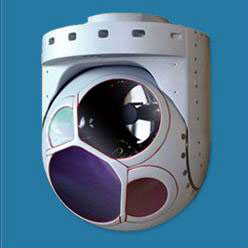 |
| AN/ASX-4 sensor turret. (Photo courtesy L3 Wescam) |
Built by L-3 Communications' Wescam unit in Toronto, the AN/ASX-4 is a high-performance, long-range multisensor imaging system suitable for larger aircraft requiring longer operational standoff distances. This is just one of the turrets in the series of EO/IR/Laser systems made by Wescam. This 21” turret combines high optical zoom performance with rock solid stabilization (<4 µrads) achieved using a military grade IMU (Inertial Measurement Unit) mounted to the optical bench inside the turret and a true 6-axis stabilized gimbal .AN/ASX-4 Turret: <91kg, 21” (D) x 26.25” (H)
MCU: 9kg, ½ ATRIncluding an effective 3000m spotter scope, the AN/ASX-4 delivers the longest range detection and identification capability of any commercially available airborne camera turret in 2010.
The payload comprises of up to 7 sensors:
1) IR (640 x 512 In Sb array, 20 micron pitch, 3-5µm wavelength, 4x FOVs (from 18.2° to 0.24°)
2) Colour daylight camera (3CCD) with zoom lens (30° to 1.6° FOV)
3) Colour daylight camera (3CCD) with step spotter lens (0.46° to 0.087° FOV)*
4) Mono low light camera (CMCCD) with step spotter lens (0.59° to 0.11° FOV)*
5) Laser rangefinder (Eye Safe, 1540nm, 30km range)
6) Wide angle laser illuminator (ANSI Class 4, 860nm)
7) Narrow angle laser illuminator (ANSI Class 4, 860nm)*other configurations available
FOV = field of visionOther features:
• AVT – Auto Video Tracker
• Multiple interfaces (including moving maps, radar, NightSun)
• Aviation grade materials, constructed to MIL-STD specifications
 |
| AN/ASX-4 sensor turret. (Photo courtesy L3 Wescam) |
BACKGROUNDERThe AN/ASX-4 started out as a three-sensor camera turret, with two daylight electro-optical (EO) cameras and a night infrared camera. Originally built for the P-3C AIP program's Advanced Imaging MultiSpectral System, it has since been upgraded with improved cameras, gimbal technology and state-of-the-art detection processing for improved performance in haze and low-light conditions.
The AN/ASX-4 now has a new high-definition imagery capability. It has proved itself in combat in Afghanistan and Iraq, especially when longer standoff ranges and pointing accuracy are required.
The first and second-generation electro-optical/infrared systems were essentially scanning mirrors but the third-generation AN/ASX-4 is a scanning array system, with fewer moving parts and higher reliability. Today, it can house up to seven sensors simultaneously.
Image-intensified low-light cameras are very susceptible to white light and cannot be used in daytime. The AN/ASX-4 uses a charge-multiplied charge coupled device (CCD) camera that allows Wescam to get rid of all the blooming effects and burn-out of low-light image-intensified cameras. A long-range EO camera, combined with a L3 Wescam night-vision camera, provide good low-light capability, especially with just a bit of moonlight.
An operator cannot read lettering on a ship or building at night with an infrared camera. With the additional laser illuminator, the charge-multiplied CCD camera can read lettering in total darkness, something never done before.
The AN/ASX-4 has excellent gimbal stability so large camera optics can be packaged in the turret thus rendering long range capability. Without the stability provided by the gimbals, the maximum range of the camera would be limited regardless of the quality of the optics. Stability is paramount!
Reference:
1) http://www.hallmedia.co.uk/products_mx20.html
2) http://findarticles.com/p/articles/mi_qa3738/is_200705/ai_n19431314/